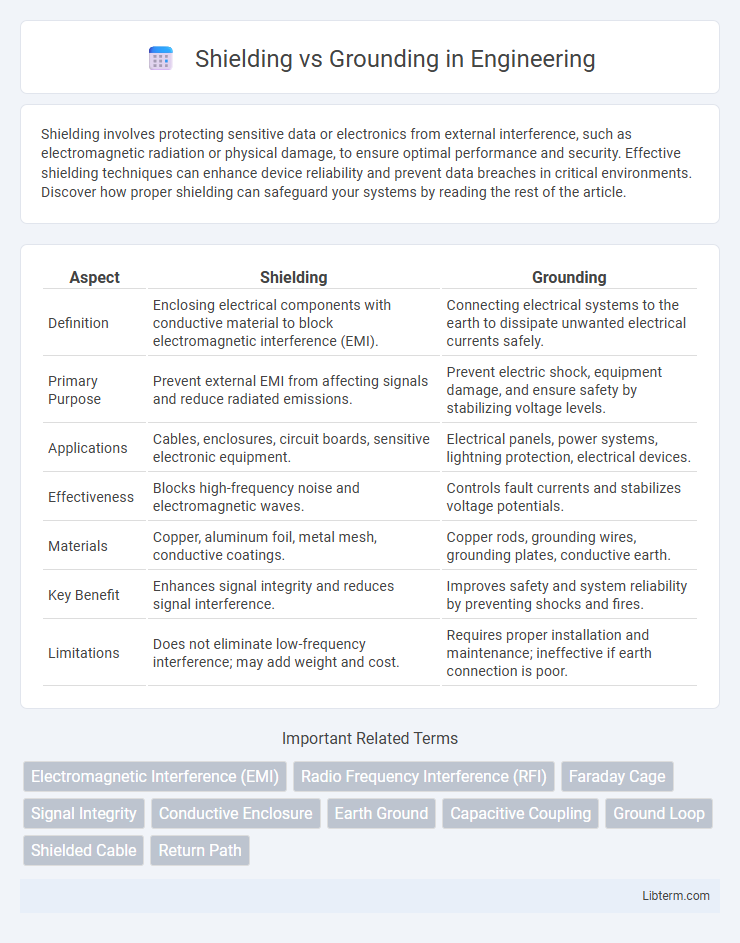Shielding involves protecting sensitive data or electronics from external interference, such as electromagnetic radiation or physical damage, to ensure optimal performance and security. Effective shielding techniques can enhance device reliability and prevent data breaches in critical environments. Discover how proper shielding can safeguard your systems by reading the rest of the article.
Table of Comparison
| Aspect | Shielding | Grounding |
|---|---|---|
| Definition | Enclosing electrical components with conductive material to block electromagnetic interference (EMI). | Connecting electrical systems to the earth to dissipate unwanted electrical currents safely. |
| Primary Purpose | Prevent external EMI from affecting signals and reduce radiated emissions. | Prevent electric shock, equipment damage, and ensure safety by stabilizing voltage levels. |
| Applications | Cables, enclosures, circuit boards, sensitive electronic equipment. | Electrical panels, power systems, lightning protection, electrical devices. |
| Effectiveness | Blocks high-frequency noise and electromagnetic waves. | Controls fault currents and stabilizes voltage potentials. |
| Materials | Copper, aluminum foil, metal mesh, conductive coatings. | Copper rods, grounding wires, grounding plates, conductive earth. |
| Key Benefit | Enhances signal integrity and reduces signal interference. | Improves safety and system reliability by preventing shocks and fires. |
| Limitations | Does not eliminate low-frequency interference; may add weight and cost. | Requires proper installation and maintenance; ineffective if earth connection is poor. |
Introduction to Shielding and Grounding
Shielding involves creating a conductive barrier to block electromagnetic interference (EMI) from affecting sensitive electronic components, commonly using materials like copper or aluminum. Grounding establishes a safe path for electrical currents to dissipate into the earth, preventing electrical shocks and equipment damage. Both techniques are essential for maintaining system integrity and minimizing noise in electrical and electronic circuits.
Understanding Electrical Noise and Interference
Shielding involves enclosing cables or electronic components with conductive materials to block electromagnetic interference (EMI) and radio frequency interference (RFI), effectively reducing electrical noise by reflecting or absorbing unwanted signals. Grounding provides a reference point for electrical circuits and safely dissipates stray currents or interference into the earth, preventing noise buildup and potential damage. Proper implementation of shielding and grounding techniques is critical in minimizing signal distortion and enhancing the performance and reliability of sensitive electronic systems.
What is Shielding?
Shielding involves the use of conductive materials to protect electronic circuits and cables from electromagnetic interference (EMI) by creating a barrier that absorbs and reflects unwanted signals. This technique significantly reduces signal degradation and noise in high-frequency applications, ensuring data integrity and improving overall system performance. Effective shielding is critical in environments with high EMI exposure, such as telecommunications, medical devices, and aerospace systems.
Types of Shielding Techniques
Types of shielding techniques include conductive shielding, which uses metal foils or meshes to block electromagnetic interference (EMI) by providing a low-resistance path for currents. Another common method is magnetic shielding, employing materials like mu-metal to redirect magnetic fields away from sensitive components. Electrostatic shielding uses grounded conductive enclosures to prevent electrostatic discharge and reduce electric field exposure in electronic systems.
Fundamentals of Grounding
Grounding is the process of creating a reference point in an electrical circuit by connecting specific parts to the earth, ensuring safety and proper operation of electrical systems. It stabilizes voltage levels, protects against electrical surges, and prevents electrical shock by providing a path for fault currents to flow directly into the ground. Proper grounding is essential for reducing electromagnetic interference and maintaining the integrity of sensitive electronic equipment.
Grounding Methods and Practices
Grounding methods in electrical systems typically include the use of grounding rods, grounding grids, and grounding electrodes, which safely dissipate electricity into the earth to prevent electrical shock and equipment damage. Common practices involve connecting all metallic parts of an electrical installation to a common ground point, ensuring low resistance paths to earth, and regularly testing ground resistance to maintain system effectiveness. Proper grounding techniques are essential for protecting sensitive electronic devices, enhancing lightning protection, and stabilizing voltage levels across power systems.
Key Differences Between Shielding and Grounding
Shielding involves enclosing cables or electronic components with conductive material to block electromagnetic interference (EMI) and prevent signal degradation, while grounding establishes a reference voltage point and safely dissipates electrical faults or static charges into the Earth. Shielding primarily targets external noise reduction by creating a barrier against interference, whereas grounding ensures electrical safety and system stability by providing a path for current flow during faults. Effective EMI control requires both shielding for noise isolation and grounding for fault current management and voltage stabilization.
Common Applications: When to Use Shielding or Grounding
Shielding is commonly used in applications requiring protection of sensitive electronics from electromagnetic interference (EMI), such as in cables, communication devices, and medical instruments. Grounding is essential for safety and system stability, employed in power distribution systems, electronic circuit protection, and lightning protection. Use shielding when reducing noise and interference is critical, while grounding is necessary for preventing electric shock and ensuring proper circuit operation.
Challenges and Pitfalls in Implementation
Shielding and grounding are critical for electromagnetic interference mitigation but pose challenges such as improper material selection that reduces effectiveness and causes signal degradation. Common pitfalls include incorrect grounding paths creating ground loops, which introduce noise rather than eliminate it, and inadequate bonding that fails to maintain consistent electrical continuity. Effective implementation requires precise design considering frequency ranges, environmental factors, and system topology to avoid unintended coupling and ensure robust interference suppression.
Best Practices for Effective Electrical Protection
Effective electrical protection relies on combining shielding and grounding strategies to minimize electromagnetic interference and ensure safety. Shielding involves using conductive barriers to block unwanted electrical noise, while grounding provides a reference point to safely dissipate fault currents and stabilize voltage levels. Best practices include proper material selection for shields, maintaining continuous grounding paths, and regular inspection to prevent corrosion and ensure optimal conductivity.
Shielding Infographic

 libterm.com
libterm.com